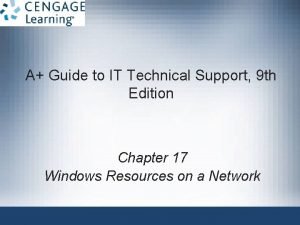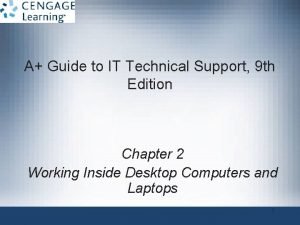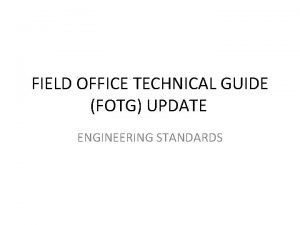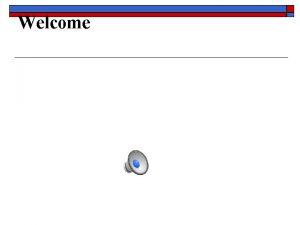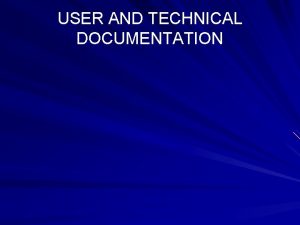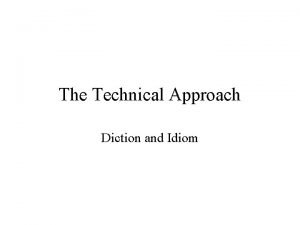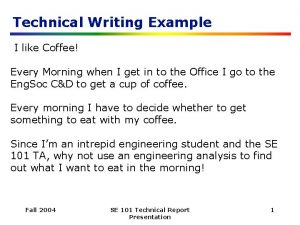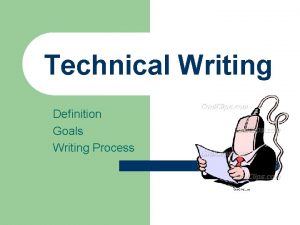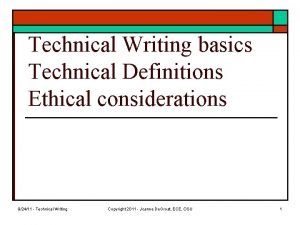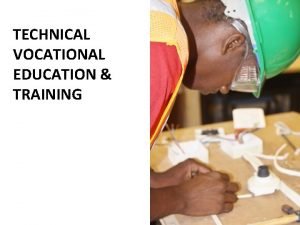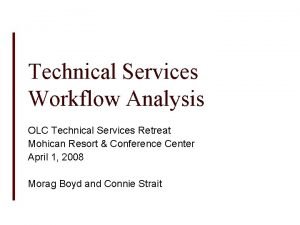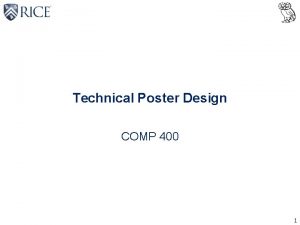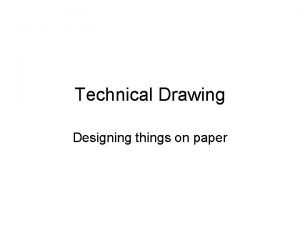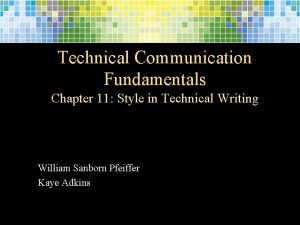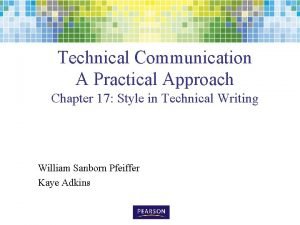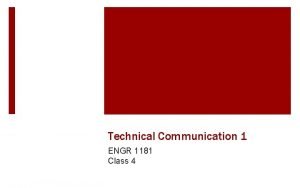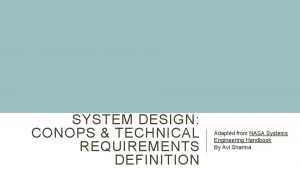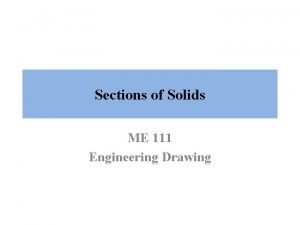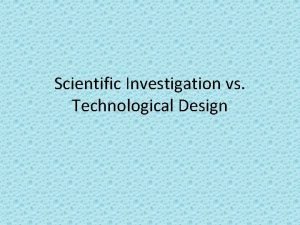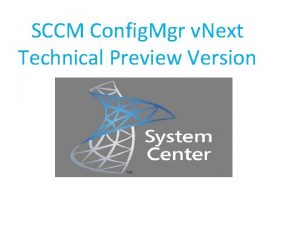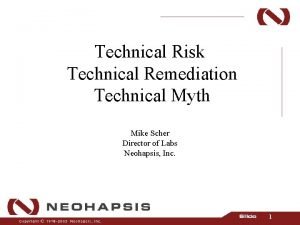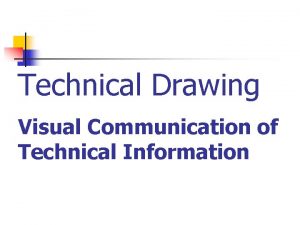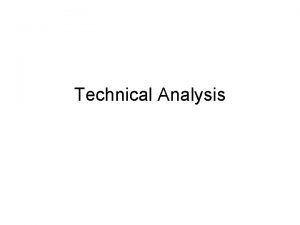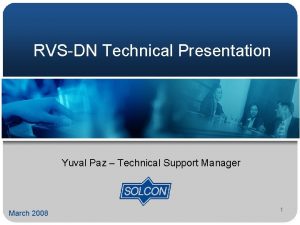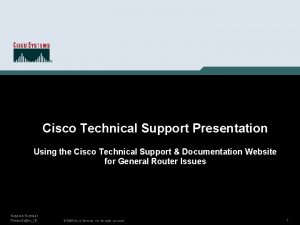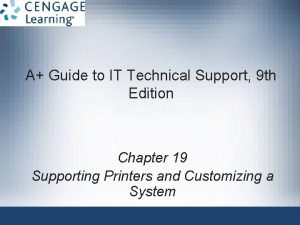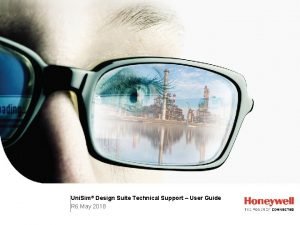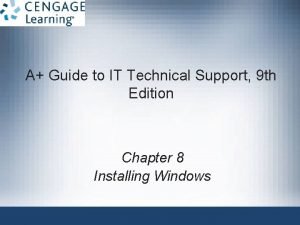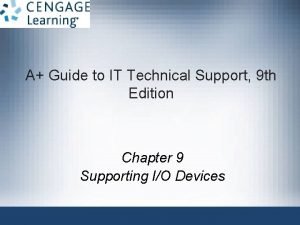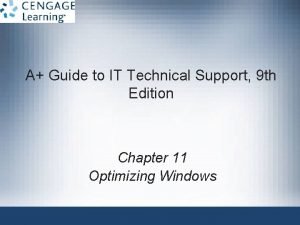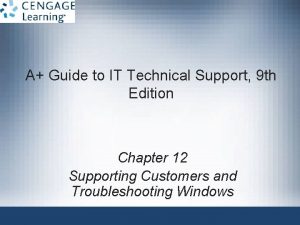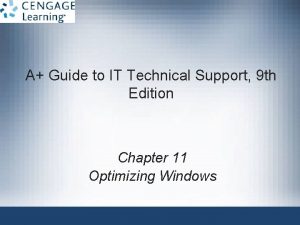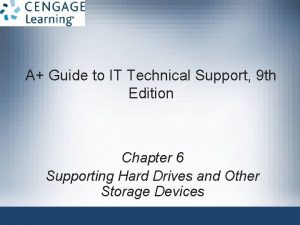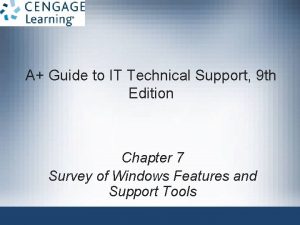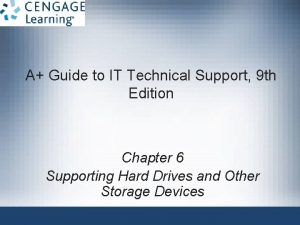A Guide to IT Technical Support 9 th


























































- Slides: 58

A+ Guide to IT Technical Support, 9 th Edition Chapter 5 Supporting the Power System and Troubleshooting Computers

Objectives • Describe the methods and devices for keeping a system cool • Select a power supply to meet the power needs of a system • Demonstrate an organized approach to solving any computer problem, especially hardware problems occurring during the boot • Troubleshoot problems with the electrical system A+ Guide to IT Technical Support, 9 th Edition 2 © Cengage Learning 2017

Objectives • Troubleshoot problems with the motherboard, processor, and RAM • Troubleshoot hardware problems with mobile devices A+ Guide to IT Technical Support, 9 th Edition 3 © Cengage Learning 2017

Cooling Methods and Devices • If processor, expansion cards, and other components overheat: – System can get unstable – Components can fail or be damaged • Devices used to cool a system: – – CPU and case fans Coolers Heat sinks Liquid cooling systems A+ Guide to IT Technical Support, 9 th Edition 4 © Cengage Learning 2017

Processor Coolers, Fans, and Heat Sinks • Computer systems use a cooling assembly designed for a specific processor to keep temperatures below the processor maximum temperature • Good processor coolers maintain a temperature of: – 90 -110 degrees F (32 -43 degrees C) • Cooler: sits on top of processor – Consists of a fan and heat sink – Heat sink: uses fins that draw heat away from processor – Fan: blows drawn heat away from CPU unit A+ Guide to IT Technical Support, 9 th Edition 5 © Cengage Learning 2017

Processor Coolers, Fans, and Heat Sinks Figure 5 -1 A cooler sits on top of a processor to help keep it cool A+ Guide to IT Technical Support, 9 th Edition 6 © Cengage Learning 2017

Processor Coolers, Fans, and Heat Sinks • Cooler (cont’d): – Made of aluminum, copper or combination of both – Bracketed to motherboard using a wire or plastic clip – A creamlike thermal compound eliminates air pockets, helping to draw heat off the processor – Gets power by using a 4 -pin fan header on the motherboard – Fanless CPU cooler (passive CPU cooler) contain heat pipes, which contain liquid that becomes vapor when heated • Vapor draws heat away from the CPU A+ Guide to IT Technical Support, 9 th Edition 7 © Cengage Learning 2017

Case Fans and Other Fans and Heat Sinks • Case fans: help draw air out of the case to prevent overheating – Most cases have one or more positions on the case to hold a case fan – Large fans tend to perform better than small fans • Other fans: – Some graphics (video) cards come with a fan – Fan cards can be mounted next to graphics cards • Be sure to select a fan card that fits the expansion slot you plan to use A+ Guide to IT Technical Support, 9 th Edition 8 © Cengage Learning 2017

Case Fans and Other Fans and Heat Sinks • Other fans (cont’d): – RAM cooler – clips over a DIMM memory module • May be powered by a SATA or 4 -pin Molex power connector Figure 5 -7 A RAM cooler keeps memory modules cool A+ Guide to IT Technical Support, 9 th Edition 9 © Cengage Learning 2017

Liquid Cooling Systems • Liquid cooling system – A small pump sits inside the case and tubes moves liquid around components and then away from them to a place where fans cool the liquid Figure 5 -8 A liquid cooling system pumps liquid outside and away from components where fans can then cool the liquid A+ Guide to IT Technical Support, 9 th Edition 10 © Cengage Learning 2017

Selecting a Power Supply • Reasons to replace a power supply: – Power supply in existing system fails – Power supply in existing system is not adequate • When building from scratch, some cases come with power supply already installed A+ Guide to IT Technical Support, 9 th Edition 11 © Cengage Learning 2017

Types and Characteristics of Power Supplies • Important power supply feature considerations: – – – Form factor determines power supply size Wattage ratings (listed in documentation) Number and type of connectors Fans inside the PSU Dual voltage options Warranty and overall quality A+ Guide to IT Technical Support, 9 th Edition 12 © Cengage Learning 2017

How to Calculate Wattage Capacity • Determining wattage capacity – Consider all components inside case – Consider USB and Fire. Wire devices • Get power from ports connected to the motherboard • Points to keep in mind – Video cards draw the most power – The power supply should be rated 30 percent higher than expected needs • What size Power Supply? – Add up wattage requirements and add 30 percent A+ Guide to IT Technical Support, 9 th Edition 13 © Cengage Learning 2017

How to Calculate Wattage Capacity Table 5 -2 To calculate the power supply rating you need, add up total wattage A+ Guide to IT Technical Support, 9 th Edition 14 © Cengage Learning 2017

How to Approach a Hardware Problem • Troubleshooting resources: – – – The web (Internet) Chat forums or email technical support Manufacturer’s diagnostic software User manuals Technical associates in your organization A+ Guide to IT Technical Support, 9 th Edition 15 © Cengage Learning 2017

Step 1: Interview the User • Include these questions: – Can you describe the problem, when did it first start, and when does it occur? – Was the computer recently moved? – Was any new hardware or software recently installed? – Was any software recently reconfigured or upgraded? – Did someone else use your computer recently? A+ Guide to IT Technical Support, 9 th Edition 16 © Cengage Learning 2017

Step 1: Interview the User • Include these questions (cont’d): – Does the computer have a history of similar problems? – Is there important data on the drive that is not backed up? – Can you show me how to reproduce the problem? • After gathering information: – Prioritize what to do and begin diagnosing and addressing the problem A+ Guide to IT Technical Support, 9 th Edition 17 © Cengage Learning 2017

Step 2: Back Up Data As Needed • Three options for backing up data: – Move the hard drive to another system – Use file recovery software – Hire a professional file recovery service • Before selecting a service, read reviews, understand the warranty and guarantees, and get a customer recommendation A+ Guide to IT Technical Support, 9 th Edition 18 © Cengage Learning 2017

Step 3: Examine the System and Establish a Theory Figure 5 -16 Use this flowchart when first facing a computer problem A+ Guide to IT Technical Support, 9 th Edition 19 © Cengage Learning 2017

Step 3: Examine the System and Establish a Theory Table 5 -5 Common beep codes and their meanings for Intel and Aware BIOS A+ Guide to IT Technical Support, 9 th Edition 20 © Cengage Learning 2017

Steps 4, 5, and 6: Fix the Problem, Verify the Fix, and Document the Outcome • After understanding the problem – Plan steps to resolve the problem • After the fix – Verify the system works by performing one last hard boot and making sure everything works as expected – Ask if anything could have been done to prevent the problem, if so, take preventative action • Most organization require documentation in a call tracking or helpdesk application – Record findings A+ Guide to IT Technical Support, 9 th Edition 21 © Cengage Learning 2017

Special Concerns when Troubleshooting Mobile Device Hardware • Factors to consider before starting repair project: – Warranty – Time the repair will take – Alternatives to repairing (upgrading) • Return notebook to manufacturer or service center • Substitute external component for internal device • Replace the internal device A+ Guide to IT Technical Support, 9 th Edition 22 © Cengage Learning 2017

Troubleshooting the Electrical System • Electrical problems can: – Occur before or after the boot – Be consistent or intermittent • Possible symptoms of electrical problem: – – – Computer appears to be “dead” Computer sometimes locks up during booting Error codes or beeps occur during booting Smell burnt parts or odors Computer powers down at unexpected times Computer appears dead except you hear a whine coming from the power supply A+ Guide to IT Technical Support, 9 th Edition 23 © Cengage Learning 2017

Troubleshooting the Electrical System • Try these simple things first: – If you small any burnt part, don’t turn system on • Find fried part and replace – If power supply is whining, don’t turn system on • Open case and look for short or consider upgrading • Test power supply with a power supply tester – Check power cord connection and power bar it may be plugged into – Is power outlet controlled by wall switch? If so, turn it on – Are any cable connections loose? A+ Guide to IT Technical Support, 9 th Edition 24 © Cengage Learning 2017

Troubleshooting the Electrical System • Try these simple things first (cont’d): – Is the circuit breaker blown? Is the house circuit overloaded? – Are all switches on the system turned on? – Is it possible the system has overheated? If so, wait awhile and try again – Older computers might be affected by electromagnetic interference (EMI) • Check for sources of EMI such as fluorescent lighting or an electric fan or copier sitting near PC A+ Guide to IT Technical Support, 9 th Edition 25 © Cengage Learning 2017

Troubleshooting the Electrical System • Problem still not solved, look inside the case: – Check all power connections from the power supply to the motherboard and drives – If you smell burnt parts, search for shorts and frayed and burnt wires – If you suspect the power supply is bad, test it with a power supply tester A+ Guide to IT Technical Support, 9 th Edition 26 © Cengage Learning 2017

Problems That Come and Go • Generally, intermittent problems are more difficult to solve • Symptoms of what may be an intermittent problem: – – – – Computer stops or hangs for no reason Memory errors appear intermittently Data is written incorrectly to the hard drive Keyboard stops working at odd times Motherboard fails or is damaged Power supply overheats and becomes hot to touch Power supply fan whines and becomes noisy A+ Guide to IT Technical Support, 9 th Edition 27 © Cengage Learning 2017

Problems That Come and Go • Eliminate the electrical system as the source of an intermittent problem: – Consider the power supply is inadequate – Suspect the power supply is faulty – The power supply fan might not work A+ Guide to IT Technical Support, 9 th Edition 28 © Cengage Learning 2017

Power Problems With the Motherboard • Short might occur if a motherboard component makes improper contact with the chassis – Can seriously damage the motherboard – Check for missing/loose standoffs or loose screws • Shorts in motherboard circuits might also cause problems – Look for damage on the bottom of the motherboard – Look for burned-out capacitors that are spotted brown or corroded A+ Guide to IT Technical Support, 9 th Edition 29 © Cengage Learning 2017

Problems With Overheating • Symptoms of overheating: – System hangs or freezes at odd times or after the boot starts – Windows BSOD (blue screen of death) error occurs during the boot – You cannot hear a fan running or the fan makes a whining sound – You cannot feel air being pulled into or out of the case • You can purchase a temperature sensor that will sound an alarm when the inside of the case is too hot A+ Guide to IT Technical Support, 9 th Edition 30 © Cengage Learning 2017

Problems With Overheating • Things to do to solve overheating: – If system hangs, go into UEFI/BIOS setup and find the CPU screen that reports temperature (should not exceed that recommended by the CPU manufacturer) – Use compressed air, a blower, or antistatic vacuum to remove dust from the power supply and vents – Check airflow inside the case to see if fans are running (may need to replace a fan) – Install extra fans if case will hold them – Can the side of the case hold a chassis air guide that guides air to the processor? If so, install one A+ Guide to IT Technical Support, 9 th Edition 31 © Cengage Learning 2017

Problems With Overheating Figure 5 -20 Dust in the cooler fan cause the fan to fail and the processor to overheat A+ Guide to IT Technical Support, 9 th Edition 32 © Cengage Learning 2017

Problems With Overheating Figure 5 -21 Install one exhaust fan on the rear of the case to help pull air through the case A+ Guide to IT Technical Support, 9 th Edition 33 © Cengage Learning 2017

Problems With Overheating • Things to do to solve overheating (cont’d): – To improve airflow, replace missing faceplates and expansion slot covers – Ensure cables are not in the way of airflow – Place case so that there a few inches of space on both sides and the top of the case – Verify the cooler is connected properly to the processor – After closing the case, leave system off for at least 30 minutes A+ Guide to IT Technical Support, 9 th Edition 34 © Cengage Learning 2017

Problems With Overheating Figure 5 -22 For optimum airflow, don’t leave empty expansion slots and bays uncovered A+ Guide to IT Technical Support, 9 th Edition 35 © Cengage Learning 2017

Problems With Overheating Figure 5 -23 Use cable ties to hold cables out of the way of fans and airflow A+ Guide to IT Technical Support, 9 th Edition 36 © Cengage Learning 2017

Problems With Overheating • Things to do to solve overheating (cont’d): – Check UEFI/BIOS setup to see if the processor is being overclocked (can cause system to overheat) – Have too many peripherals been installed inside the case? Try to leave an empty slot between each card – Flash UEFI/BIOS to update firmware on motherboard – Replace thermal compound if it has hardened A+ Guide to IT Technical Support, 9 th Edition 37 © Cengage Learning 2017

Problems With Overheating Figure 5 -25 Vents and fans need to be arranged for best airflow A+ Guide to IT Technical Support, 9 th Edition 38 © Cengage Learning 2017

Problems With Overheating • Use a power supply that has vents on the bottom and front for better ventilation Figure 5 -26 This power supply has vents on the bottom to provide better airflow inside the case A+ Guide to IT Technical Support, 9 th Edition 39 © Cengage Learning 2017

Problems With Overheating • An intake fan on the front of the case might help pull air into the case • Check with processor and case manufacturers – For specific instructions as to the placement of fans and what type of fan and heat sink to use • Intel and AMD recommend a chassis air guide (CAG) as part of the case design – A round air duct that helps pull and direct fresh air from outside the case to the cooler and processor A+ Guide to IT Technical Support, 9 th Edition 40 © Cengage Learning 2017

Problems with Laptop Power Systems • Laptop power sources – AC adapter or a battery pack – Today’s batteries use lithium ion technology • Auto-switching AC adapter feature – Device automatically switches from 110 V to 220 V AC power • Some laptops use two batteries – Second battery is known as a sheet battery A+ Guide to IT Technical Support, 9 th Edition 41 © Cengage Learning 2017

Problems with Laptop Power Systems • If power is not getting to the system or battery indicator light is lit: – Verify the AC adapter is plugged into an outlet – Check if AC adapter’s plug is secure outlet – Check connections on both sides of AC adapter transformer – Check connection at notebook • If battery is not charging when AC adapter is plugged in, problem might be with battery or motherboard A+ Guide to IT Technical Support, 9 th Edition 42 © Cengage Learning 2017

Troubleshooting the Motherboard, Processor, and RAM • Symptoms that a motherboard, processor, or memory is failing: – – – System begins to boot but then powers down Error message is displayed during the boot System reports less memory than installed System becomes unstable, hangs, or freezes Intermittent Windows or hard drive errors occur Components on the motherboard or devices connected to it don’t work • Check simple things first A+ Guide to IT Technical Support, 9 th Edition 43 © Cengage Learning 2017

Troubleshooting the Motherboard, Processor, and RAM • Follow these steps to find source of problem: – 1. Search the Internet for the error message – 2. Run antivirus software to check for viruses – 3. A memory module might be failing • Use Memory Diagnostics tool to test memory – 4. Check for potential hardware problems using Device Manager – 5. Download and install any Windows updates or patches – 6. If problem began after a change or new install, uninstall device or application A+ Guide to IT Technical Support, 9 th Edition 44 © Cengage Learning 2017

Troubleshooting the Motherboard, Processor, and RAM • Follow these steps to find source of problem (cont’d): – 7. Use System window to find out how much RAM is installed (consider upgrading if not enough) – 8. Check UEFI/BIOS setup to ensure proper settings – 9. Disable any quick booting features in BIOS • Then look for errors reported during the boot – 10. Flash BIOS to update firmware on the board – 11. Check CD that came with motherboard • May have diagnostic tests – 12. Update all drivers of motherboard components that are not working A+ Guide to IT Technical Support, 9 th Edition 45 © Cengage Learning 2017

Troubleshooting the Motherboard, Processor, and RAM • Follow these steps to find source of problem (cont’d): – 13. If an onboard port is not working: • Verify the problem is not with the device using the port • Go into UEFI/BIOS setup and verify the port is enabled • Check Device Manager and verify Windows recognizes port with no errors • Update motherboard drivers for this port from manufacturer’s web site • Use a loop-back plug to test the port • Disable the port in BIOS setup and install an expansion card A+ Guide to IT Technical Support, 9 th Edition 46 © Cengage Learning 2017

Troubleshooting the Motherboard, Processor, and RAM • Follow these steps to find source of problem (cont’d): – 14. Suspect the problem is a failing hard drive – 15. Suspect the problem is caused by overheating – 16. Verify the installed processor is supported by the motherboard A+ Guide to IT Technical Support, 9 th Edition 47 © Cengage Learning 2017

Troubleshooting the Motherboard, Processor, and RAM • For Windows 8, many continuous restart errors can be solved by performing a Startup Repair process • For Windows 7/Vista, error messages disappear before they can be read as the system reboots – Disable automatic restarts by using the Advanced Boot Options menu (press F 8 as Windows starts) A+ Guide to IT Technical Support, 9 th Edition 48 © Cengage Learning 2017

Troubleshooting the Motherboard, Processor, and RAM • If you have checked Windows and UEFI/BIOS settings and have not identified the source of the problem, open the case and check inside • With the case open, follow these steps: – 1. Check that all power and data cables are securely connected – 2. Look for physical damage on the motherboard – 3. Reduce the system to essentials – 4. Try using a POST diagnostic card – 5. Suspect the problem is caused by a failing power supply A+ Guide to IT Technical Support, 9 th Edition 49 © Cengage Learning 2017

Troubleshooting the Motherboard, Processor, and RAM • With the case open, follow these steps (cont’d): – 6. Exchange the processor – 7. Exchange the motherboard • Before you do this, measure the voltage output of the power supply or replace it (in case it damaged the motherboard) A+ Guide to IT Technical Support, 9 th Edition 50 © Cengage Learning 2017

Troubleshooting Mobile Devices • Solutions for a cell phone that is overheating: – Check if heat is coming from the bottom of cell phone, where battery is located • Use different AC adapter to charge battery • Examine battery for damage (if no longer under warranty) – If heat is coming from other areas of the phone: • • Too many apps might be open Follow troubleshooting steps for phone’s OS Phone processor might be overworked (allow to cool) Remove phone from case A+ Guide to IT Technical Support, 9 th Edition 51 © Cengage Learning 2017

Troubleshooting Mobile Devices • Other problems and solutions: – For a frozen system: • For i. Phone or i. Pad, reset the device • For Android device, reboot the system by following manufacturer directions for a reboot • For Windows Phone, hold down the Power button and then swipe Slide down to power off – Battery charge lasts a short time • Try exchanging the AC adapter • If that doesn’t work, exchange battery unless device is under warranty A+ Guide to IT Technical Support, 9 th Edition 52 © Cengage Learning 2017

Troubleshooting Mobile Devices • Other problems and solutions: – When installing apps that don’t load or load slowly • A hot or failing battery might be the problem – For slow performance, close apps you’re not using, clean Android cached data, and disable live wallpapers – If device is unable to decrypt email, may need to generate a new public key and private key and distribute your new public key to those who send encrypted email A+ Guide to IT Technical Support, 9 th Edition 53 © Cengage Learning 2017

Summary • Devices used to keep a processor and system cool include CPU coolers, fans, heat sinks, and liquid cooling • Liquid cooling system use liquids pumped through system to keep it cool • Important features of a power supply to consider when purchasing it are: form factor, wattage capacity, number and type of connectors, fan size, support dual video cards, and warranty • To decide on the wattage capacity of a power supply, add up the wattage requirements for all components and add 30 percent A+ Guide to IT Technical Support, 9 th Edition 54 © Cengage Learning 2017

Summary • Always begin troubleshooting by interviewing the user • When troubleshooting, check the simple things first • Decide if problem occurs before or after a successful boot and if it is caused by hardware or software • When troubleshooting mobile devices, consider the warranty and that replacing a component might cost more than replacing the device • Listen for spinning fans or drives and look for indicator lights to ensure a system is getting power A+ Guide to IT Technical Support, 9 th Edition 55 © Cengage Learning 2017

Summary • Use a power supply tester to test the power supply • Intermittent problems that come and go are the most difficult to solve • Removing dust from a system, providing for proper ventilation, and installing extra fans can help keep a system from overheating • The battery and DC jack are considered field replaceable units in a laptop that pertain to the power system • Use a multimeter to check the voltage output of an AC adapter A+ Guide to IT Technical Support, 9 th Edition 56 © Cengage Learning 2017

Summary • UEFI/BIOS gives beep codes when a POST error occurs during the boot before it tests video • Error messages on a black screen during the boot are usually put there by startup UEFI/BIOS during the POST • An unstable system that freezes or hangs at odd times can be caused by a faulty power supply, RAM, hard drive, motherboard, processor, Windows error, or overheating • A POST diagnostic card can troubleshoot problems with the motherboard A+ Guide to IT Technical Support, 9 th Edition 57 © Cengage Learning 2017

Summary • A mobile device battery that overheats or quickly loses its charge might need replacing, but first try replacing the AC adapter • For a frozen system, try resetting an i. Phone or i. Pad, rebooting an Android device, or resetting a Windows Phone A+ Guide to IT Technical Support, 9 th Edition 58 © Cengage Learning 2017
 A guide to it technical support
A guide to it technical support A guide to it technical support
A guide to it technical support Ibm technical support services
Ibm technical support services Cisco ios upgrade planner tool
Cisco ios upgrade planner tool Multilingual technical support
Multilingual technical support Technical services support cloud computing
Technical services support cloud computing System galaxy tech support
System galaxy tech support Apprenticeship technical funding guide
Apprenticeship technical funding guide Nrcs fotg
Nrcs fotg Fotg
Fotg Signal words
Signal words Yildiz technical university erasmus
Yildiz technical university erasmus Solihull technical college
Solihull technical college What does whmis stand for
What does whmis stand for Whmis consumer symbols
Whmis consumer symbols Examples of technical communication
Examples of technical communication Aob india competitors
Aob india competitors What is this image called
What is this image called Computer system documentation
Computer system documentation What is a liquid diet
What is a liquid diet Technical performance parameters
Technical performance parameters Technical writing quiz
Technical writing quiz What is technical diction
What is technical diction Regional technical forum
Regional technical forum Which post holds up the greater part of the load
Which post holds up the greater part of the load Tech voc definition
Tech voc definition Vocabulary of technical writing
Vocabulary of technical writing What are the characteristics of technical writing
What are the characteristics of technical writing Technical writing examples
Technical writing examples Teknikal na salita
Teknikal na salita Formal definition examples
Formal definition examples Definition of technical vocational
Definition of technical vocational Olc technical services retreat
Olc technical services retreat Technical scope document
Technical scope document Comp 400
Comp 400 Technical performance measures systems engineering
Technical performance measures systems engineering What does technical language mean
What does technical language mean Technical guidelines for disposal to land
Technical guidelines for disposal to land Conceptual drawing engineering
Conceptual drawing engineering Technical descriptions
Technical descriptions Style in technical communication
Style in technical communication Technical writing style
Technical writing style Technical communication examples
Technical communication examples Technical capacity example
Technical capacity example Technical bid evaluation
Technical bid evaluation Tcs technical hierarchy
Tcs technical hierarchy Tata cara technical meeting lomba
Tata cara technical meeting lomba Technical requirements definition
Technical requirements definition An/pyq 10
An/pyq 10 Characteristics of technical communication
Characteristics of technical communication Section of cone in engineering drawing
Section of cone in engineering drawing Scientific vs technical
Scientific vs technical Sccm technical preview
Sccm technical preview Rundown technical meeting lomba
Rundown technical meeting lomba What is
What is Rajamangala university of technology thanyaburi
Rajamangala university of technology thanyaburi Properties in art
Properties in art Technical decisions in project charter
Technical decisions in project charter Mrts formula
Mrts formula
